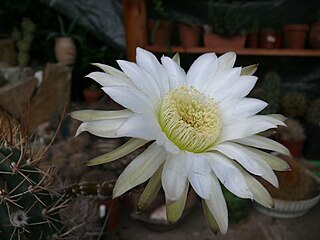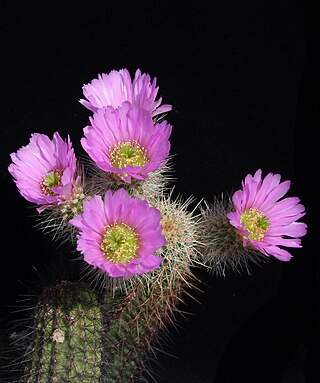
Stetsonia coryne, the toothpick cactus, is the sole species in the cactus genus Stetsonia. Stetsonia coryne grows to a height of 15 to 25 ft tall. It has white flowers.

Leuchtenbergia is a genus of cactus which has only one species, Leuchtenbergia principis. It is native to north-central Mexico. The genus is named after Maximilian Eugen Joseph (1817–1852), Duke of Leuchtenberg and amateur botanist.

Yavia cryptocarpa is a species of cactus and the only species of the newly discovered genus Yavia. The genus is named after Argentina's department Yavi, Jujuy Province, where the plant is endemic to sparsely vegetated rocky slopes. The plant is also sometimes put in the tribe Notocacteae. The specific epithet cryptocarpa refers to the plant being a cryptocarp. This means that the fruits are formed inside the plant's body, thus being only visible when the plant shrinks in the drought period.

Ferocactus cylindraceus is a species of barrel cactus which is known by several common names, including California barrel cactus, Desert barrel cactus, compass barrel cactus, and miner's compass. It was first described by George Engelmann in 1853.

Ferocactus echidne is a barrel cactus in the genus Ferocactus. It is found in nature in Mexico. This cactus is known commonly as Sonora barrel, Coville's barrel cactus, Emory's barrel cactus, and traveler's friend. This plant is often sold as a houseplant.

Soehrensia candicans is a species of cactus from northern and western Argentina. It has large fragrant white flowers that open at night.

Pachycereus pecten-aboriginum is a columnar cactus plant native to Mexico. They can grow up to 15 m (49 ft) high. The trunk of this species is 1.2 to 5.0 m tall and the fruits are large and burr-like. The specific name, pecten-aboriginum, is from the Latin, and means "native combs". It was inspired by the use of the fruits as hair combs.

Ferocactus emoryi, known commonly as Emory's barrel cactus, Coville's barrel cactus and traveler's friend, is a barrel cactus in the genus Ferocactus.

Oreocereus celsianus, or the old man of the mountain is a member of the family Cactaceae native to the high lands of the Andes in South America, and is named for its fluffy white hair, which may protect it from intense sunlight and extreme temperatures.

Ferocactus diguetii, commonly known as the giant barrel cactus, is the largest species of barrel cactus in the genus Ferocactus. It is an insular species endemic to several of Baja California Sur's southern islands in the Gulf of California. As the superlative giant of the barrel cacti, it reaches heights of up to 4 metres (13 ft) and diameters of 1 metre (3.3 ft) in the wild, a result of island gigantism. The species has red flowers that bloom from March to May. Although restricted in range, this species grows in protected habitat and lacks major threats.

Lobivia bridgesii, is a species of Lobivia found in Bolivia.

Lobivia obrepanda, is a species of Lobivia found in Bolivia.

Lobivia pentlandii, is a species of Lobivia found in Bolivia and Peru.

Echinopsis strigosa, is a species of Soehrensia in the cactus family. It is native to north western Argentina. It was first published in Cactaceae Syst. Init. 28: 31 in 2012.

Echinocereus scheeri is a species of hedgehog cactus in the family Cactaceae, native to northern Mexico. With its dramatic offsets, it has gained the Royal Horticultural Society's Award of Garden Merit.

Polaskia chichipe is a succulent cactus native to a small area of mountains of northern Oaxaca and southern Puebla, Mexico. It grows in xerophytic shrubland between 1,600 and 2,300 meters above sea level.

Neoraimondia arequipensis, synonym Neoraimondia macrostibas, is a tree-like cactus native to western Peru. It was first described in 1835 as Cereus arequipensis.

Matucana haynii is a species of Matucana found in Peru.

Acanthocalycium leucanthum is a species of flowering plant in the cactus family Cactaceae from Argentina.

Echinocereus spinigemmatus is a species of cactus native to Mexico.





















